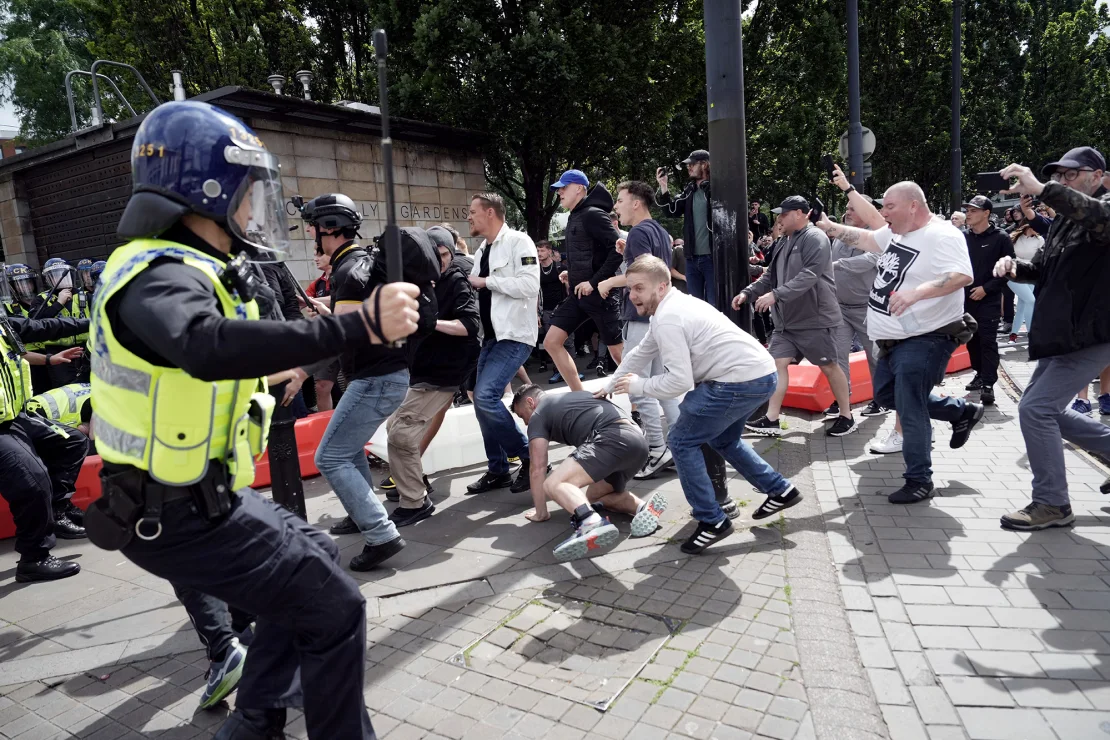
Violent Riots and Racist Attacks Spread Across British Cities: What’s Happening and What’s Next?

Recent days have seen a surge of violent riots sweeping across Britain, inciting fears of further anti-immigrant violence. The new UK government is grappling to control the worst disorder in more than a decade.
What Happened?
On Monday night, police officers were injured in Plymouth as violent crowds descended on the city. Over the weekend, far-right agitators set fire to hotels housing asylum seekers in two cities, trapping and terrifying those inside. In other cities, rioters damaged public buildings and clashed with police, throwing objects and smashing vehicles.
The unrest began late last month after an anti-immigrant misinformation campaign sparked outrage over a stabbing in Southport, northern England, that left three children dead. Prime Minister Keir Starmer, chairing his first COBRA session on Monday morning, condemned the violence, stating, “This is not protest. It is organized, violent thuggery and it has no place on our streets, or online.”
The Government’s Response
This is the first major crisis for Starmer, who became Britain’s leader a month ago after his Labour Party won the general election. His actions in the coming days will be closely watched by both lawmakers and the public. Here’s what we know about the violence and what might come next.
Breakdown of the Riots
From Friday to Sunday, violent protesters gathered in city centers across the UK, clashing with police and causing widespread havoc. These gatherings, initially anti-immigration marches organized via social media platforms like X (formerly Twitter), WhatsApp, and Telegram, quickly turned violent.
Two Holiday Inn hotels, one in Rotherham, northern England, and another in Tamworth, central England, were set ablaze by rioters. These hotels housed asylum seekers awaiting decisions on their claims. In Rotherham, terrified residents and staff were trapped inside as rioters threw wooden planks and used fire extinguishers against officers. Similar scenes unfolded in Tamworth, where rioters smashed windows, started fires, and injured one police officer.
Violence also erupted in Sunderland, Middlesbrough, Stoke-on-Trent, and other cities, primarily in the Midlands and northern England. The Home Office announced increased security for mosques across the UK.

Arrests and Future Measures
Over 370 people were arrested following the weekend’s violence, with more arrests expected as authorities use facial recognition and other technologies to identify suspects. Starmer emphasized the need for safety, stating, “People in this country have a right to be safe, and yet we’ve seen Muslim communities targeted, attacks on mosques, other minority communities singled out, Nazi salutes in the street, attacks on the police, wanton violence alongside racist rhetoric.”
Causes of the Unrest
The immediate trigger for the violence was the stabbing of several children in Southport, northwest England. Far-right groups exploited the incident, spreading false claims that the suspect was an immigrant. However, police confirmed the suspect was born in Britain. Anti-migrant rhetoric has been increasing in Britain, emboldening far-right sympathizers and contributing to the recent violence.
Political Reactions
The recent general election saw Reform UK, a right-wing populist party, gain significant votes with an anti-migration platform. While its leader, Nigel Farage, condemned the riots, he criticized the perceived “soft” policing of previous anti-racism riots and mass migration’s impact on communities. Former Conservative Home Secretary Priti Patel and Labour MP Diane Abbott both condemned the violence, with Abbott pointing out the fear among black and brown communities.
Criticism of Social Media
The riots were organized on social media and messaging services, leading to criticism of platforms like X. Far-right figureheads, including Tommy Robinson, used these platforms to encourage protests. Joe Mulhall from Hope Not Hate highlighted the dangers of allowing extremists back onto these platforms.
Starmer’s Crisis Management
This crisis is reminiscent of the 2011 riots, which Starmer, then Director of Public Prosecutions, managed by swiftly processing rioters. He has taken similar steps now, allowing courts to operate longer hours. However, he faces unique challenges, including overcrowded prisons and underfunded public services. MPs from various political parties have urged Starmer to recall Parliament from its summer recess for a debate on the riots.
Starmer’s spokesperson stated that the government is focused on responding to the riots, indicating the seriousness of the situation and the immediate need for effective measures.
Conclusion
The violent riots in British cities are a significant challenge for the new government. As Prime Minister Keir Starmer navigates this crisis, his actions will be closely scrutinized by both the public and lawmakers. The future steps taken to address this unrest and prevent further violence will be crucial in restoring order and ensuring the safety of all communities in the UK.



